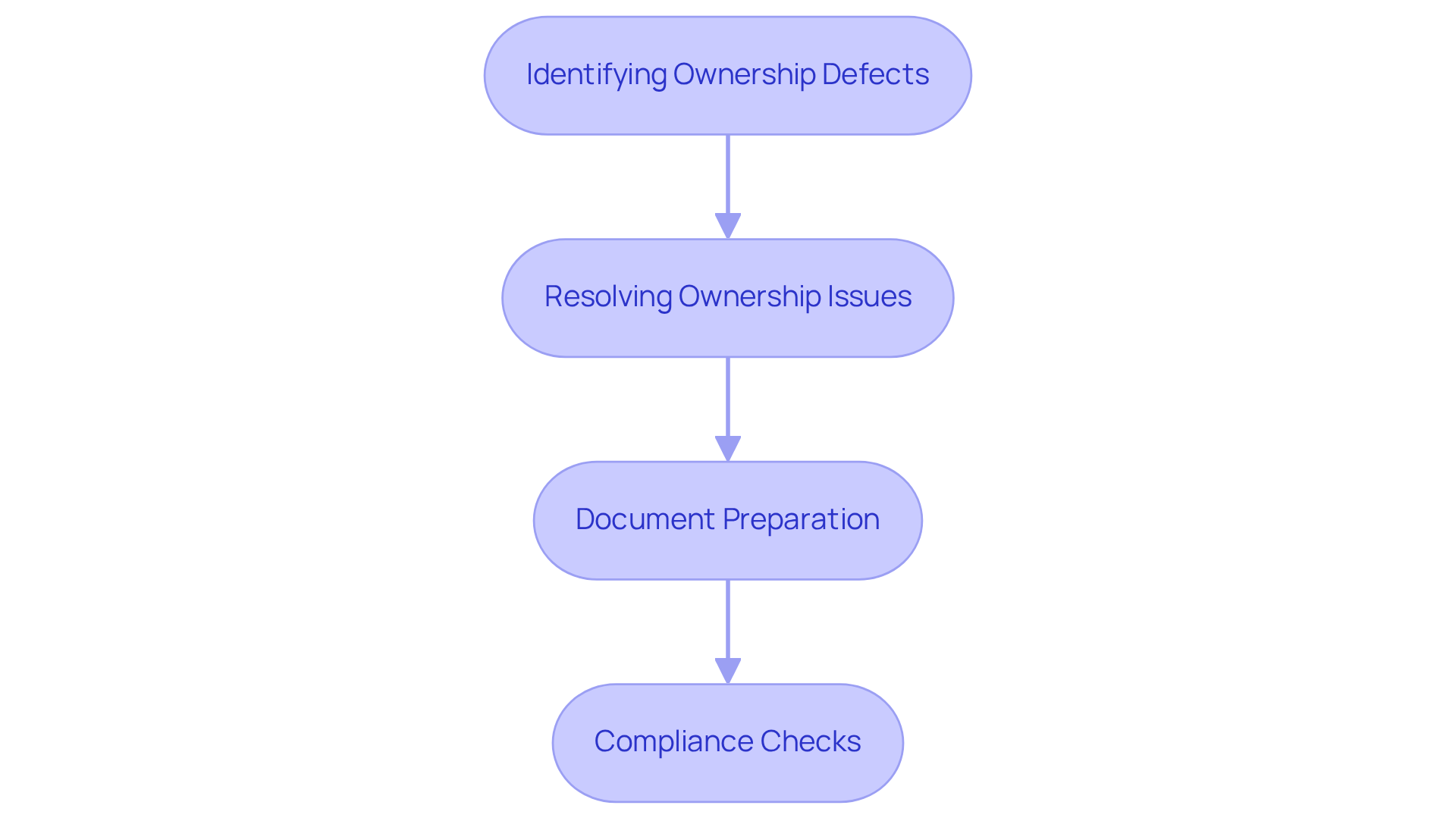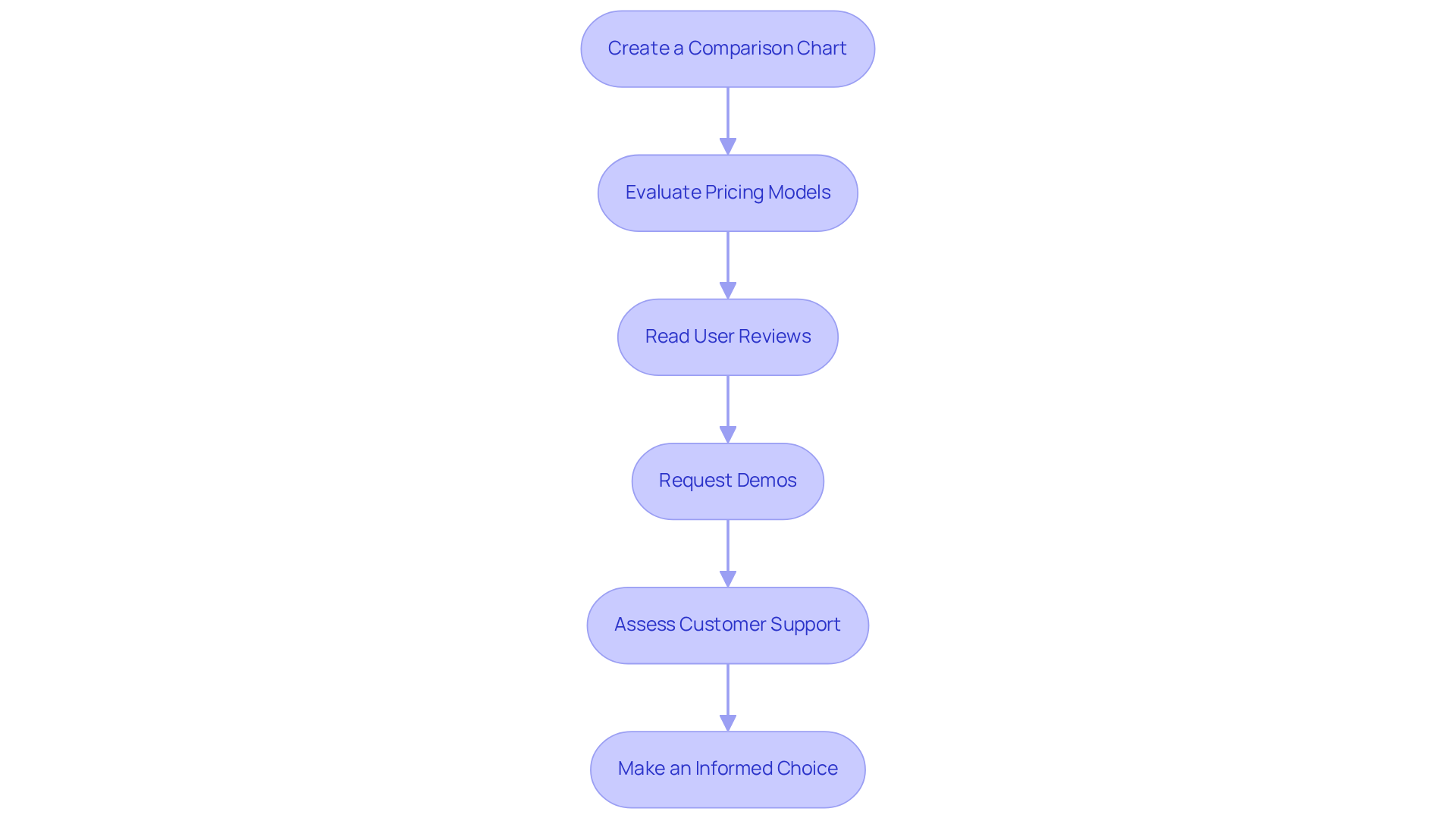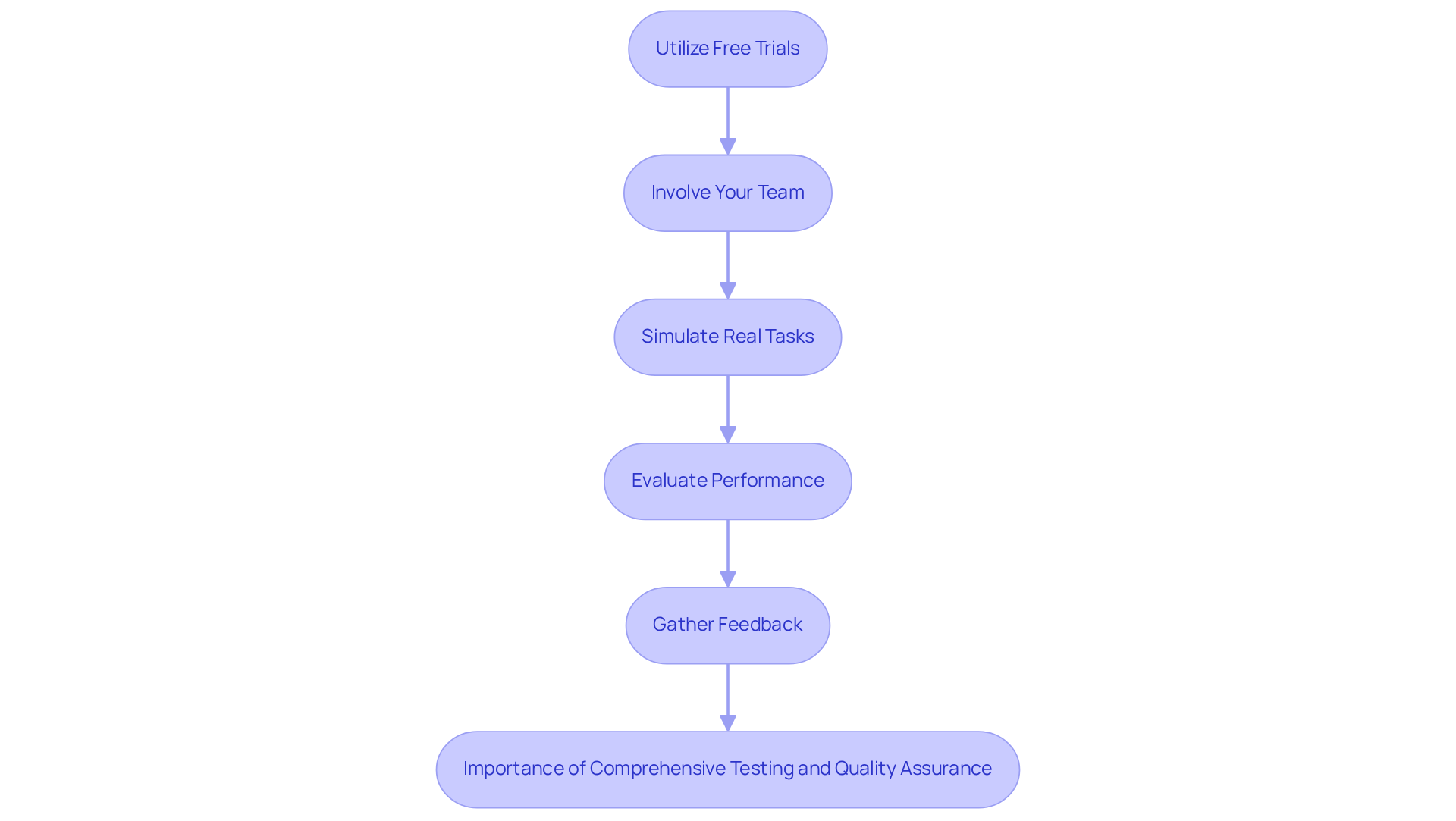Overview
The central inquiry explored in this article pertains to the effective selection of software for probate-related title curative tasks. It delineates a comprehensive four-step process:
- Understanding the essential features required for the software.
- Comparing various solutions.
- Conducting thorough testing to verify that the chosen software aligns with operational needs.
This meticulous approach ultimately enhances efficiency and accuracy in addressing title issues.
Introduction
Navigating the complexities of probate-related title curative tasks is a formidable challenge, particularly when ownership documents are fraught with defects that may obstruct property transactions. The right software can significantly streamline this process, ensuring clarity and compliance while protecting against potential legal complications.
However, with a plethora of options available, how can one ascertain which software solution genuinely aligns with their needs and enhances operational efficiency? This article explores the crucial steps for selecting the optimal software for probate-related title curative tasks, equipping readers with the insights necessary to make informed decisions.
Understand Probate-Related Title Curative Tasks
The use of software for is essential for ensuring that ownership documents are clear and marketable. These tasks typically encompass several critical activities:
- Identifying Ownership Defects: This essential step involves a comprehensive examination of ownership documents to uncover discrepancies that could affect possession, such as liens, easements, or inaccuracies in legal descriptions. Research suggests that a considerable proportion of ownership flaws occur during probate proceedings, highlighting the necessity for using software for probate-related title curative tasks to ensure a thorough review. For instance, real estate lawyers often find issues like undisclosed heirs or unresolved liens that can complicate property transfers.
- Resolving Ownership Issues: Addressing ownership disputes may necessitate initiating probate proceedings for deceased owners or managing claims from potential heirs. This process is vital to clarify rightful ownership and prevent future legal complications.
- Document Preparation: This entails creating essential legal documents to correct ownership defects, including affidavits or corrective deeds. Proper documentation is essential to ensure that all corrections are legally binding and recognized.
- [Compliance Checks](https://parseai.co/resources): Ensuring that all actions comply with local laws and regulations governing property ownership and transfers is critical. This step safeguards against possible legal issues and strengthens the integrity of the ownership.
Real estate experts highlight that clear property documents are essential for successful transactions. As one expert observed, "A clear designation is not merely a legal formality; it is the foundation of trust in real estate transactions." Furthermore, based on industry data, roughly 30% of ownership defects are recognized during probate procedures, which underscores the importance of utilizing software for probate-related title curative tasks to conduct a comprehensive ownership review. Comprehending these tasks will assist you in choosing applications that efficiently simplify these procedures, improving effectiveness and precision in document correction efforts.

Identify Key Features for Title Curative Software
When selecting software for probate-related title curative tasks, it is essential to focus on the following features:
- Document Management: The application must enable effortless storage, retrieval, and arrangement of document titles, ensuring that all relevant information is easily accessible. is crucial for maintaining compliance and enhancing workflow efficiency. As Prerna Mehta, an Enterprise Architect, states, "They offer a comprehensive software for probate-related title curative tasks that addresses and rectifies title issues, providing a clean and marketable title to buyers, lenders, and investors."
- Automated Workflows: Choose a tool that automates repetitive tasks, such as generating standard documents and sending compliance reminders. The use of software for probate-related title curative tasks not only saves time through automation but also minimizes the risk of human error, allowing your team to focus on more complex issues. Qualia users report a 75% reduction in workload, highlighting the efficiency gains from automation.
- Integration Capabilities: Ensure the software can integrate with existing tools, such as accounting or case management systems. This capability streamlines operations and improves data consistency across platforms, which is essential for efficient research on titles through the use of software for probate-related title curative tasks. For example, E-Closing modernizes ownership operations, enabling seamless integration with various services.
- Reporting and Analytics: The ability to produce detailed reports on item defects, resolutions, and compliance status is essential. This feature helps in monitoring progress and making knowledgeable choices, ultimately enhancing the overall efficiency of your reclamation processes. The ALTA Insurance Curative Work Study highlights the significance of data in measuring the work involved in the development of software for probate-related title curative tasks.
- User-Friendly Interface: A simple and intuitive interface is critical for reducing the learning curve and boosting productivity. Software that is easy to navigate allows your team to quickly adapt and utilize its features effectively. PropLogix's property verification services illustrate how user-friendly solutions can save agents hours on each closing, improving overall efficiency.
Compare Software Solutions for Title Curative Tasks
To effectively compare software solutions for title curative tasks, follow these steps:
- Create a Comparison Chart: Compile a list of the application options you are considering, detailing their key features side by side. This visual representation facilitates quick identification of which program aligns best with your specific needs.
- Evaluate Pricing Models: Analyze the cost structure of each application, including subscription fees, setup costs, and any additional charges for features or support. Comprehending the pricing structures is essential, as property remediation services can vary from $15.00 to $150.00 based on complexity. Remarkably, efficient curative solutions can result in considerable savings; for example, ProTitleUSA saved a client $480,000 in discounts requested by a purchaser, emphasizing the financial significance of selecting the appropriate program.
- Read User Reviews: Seek feedback from other users within the real estate and title research sectors to assess satisfaction levels and performance metrics. User experiences provide valuable insights into the system's reliability and effectiveness. As Brittany Wrenn, with over 12 years of experience, emphasizes, understanding user feedback is essential for making informed decisions.
- Request Demos: Take advantage of demonstrations or trial periods offered by most application providers. This hands-on experience allows you to evaluate how the software for probate-related title curative tasks performs in real-world scenarios, ensuring it meets your operational requirements.
- Assess Customer Support: Investigate the level of customer support provided by each vendor. Responsive and effective assistance is crucial, particularly when dealing with intricate ownership matters that may occur during transactions. For instance, Covius has created a workflow procedure that attains a 99% accuracy rate for recordable loan modifications, showcasing how effective assistance can improve the resolution process.
After completing these steps, you will be better prepared to make a knowledgeable choice on the application that best addresses your needs for document correction.

Test Software Options Before Finalizing Your Choice
Before finalizing your choice of software for probate-related title curative tasks, it is imperative to conduct thorough testing to ensure that it meets your needs effectively.
- Utilize Free Trials: Leverage free trials offered by vendors to explore their functionalities and assess user experience firsthand.
- Involve Your Team: Engage team members who will actively utilize the application in the testing process to gather diverse feedback on usability and features.
- Simulate Real Tasks: During the trial, use the software for probate-related title curative tasks to replicate actual title curative tasks and assess how effectively the application meets your specific requirements.
- Evaluate Performance: Assess the application's speed, reliability, and user-friendliness throughout the testing phase to confirm it aligns with your expectations.
- Gather Feedback: After testing, collect insights from all users involved to discuss the advantages and disadvantages of each option before making a final decision.
As Karl Wiegers aptly noted, "The bitterness of poor quality remains long after the sweetness of meeting the schedule has been forgotten." This underscores the significance of comprehensive testing and quality assurance in . Furthermore, consider how Parse AI has revolutionized title research by utilizing machine learning and optical character recognition to enhance efficiency, illustrating the tangible benefits of effective software for probate-related title curative tasks.

Conclusion
Selecting the right software for probate-related title curative tasks is crucial for ensuring clear and marketable property ownership. Understanding the intricacies of these tasks—such as identifying ownership defects, resolving disputes, preparing documentation, and ensuring compliance—enables individuals to streamline their processes and enhance efficiency. The right software can significantly improve the accuracy and speed of these tasks, ultimately facilitating smoother real estate transactions.
Key features to consider when choosing software include:
- Document management capabilities
- Automated workflows
- Integration with existing systems
- Robust reporting and analytics
- User-friendly interface
Each of these elements plays a vital role in simplifying the complexities associated with probate-related title curative tasks. Furthermore, conducting thorough comparisons of software solutions, including user reviews and trial testing, ensures that the chosen application aligns with specific operational needs.
In conclusion, investing time and effort into selecting appropriate software can yield substantial benefits—not only in terms of efficiency but also in reducing the risk of legal complications in property transactions. By prioritizing the right features and conducting comprehensive evaluations, real estate professionals can enhance their workflows and provide clients with the clarity and trust that are essential in the industry. Embracing these best practices will consequently lead to more successful and streamlined real estate dealings.
Frequently Asked Questions
What are probate-related title curative tasks?
Probate-related title curative tasks involve several critical activities aimed at ensuring ownership documents are clear and marketable. These tasks include identifying ownership defects, resolving ownership issues, document preparation, and compliance checks.
Why is identifying ownership defects important?
Identifying ownership defects is crucial because it involves examining ownership documents to uncover discrepancies that could affect possession, such as liens, easements, or inaccuracies in legal descriptions. Many ownership flaws occur during probate proceedings, making this step essential for a thorough review.
What issues might arise during the identification of ownership defects?
Issues that may arise include undisclosed heirs, unresolved liens, and inaccuracies in legal descriptions, which can complicate property transfers.
How are ownership issues resolved in probate?
Resolving ownership issues may require initiating probate proceedings for deceased owners or managing claims from potential heirs to clarify rightful ownership and prevent future legal complications.
What does document preparation involve?
Document preparation involves creating essential legal documents, such as affidavits or corrective deeds, to correct ownership defects. Proper documentation ensures that all corrections are legally binding and recognized.
Why are compliance checks necessary?
Compliance checks are necessary to ensure that all actions comply with local laws and regulations governing property ownership and transfers. This step helps safeguard against potential legal issues and strengthens the integrity of ownership.
What is the significance of clear property documents in real estate transactions?
Clear property documents are essential for successful transactions, as they serve as the foundation of trust in real estate dealings. Without clear documentation, legal complications can arise during property transfers.
What percentage of ownership defects are recognized during probate procedures?
Approximately 30% of ownership defects are recognized during probate procedures, highlighting the importance of using software for probate-related title curative tasks to conduct a comprehensive ownership review.




